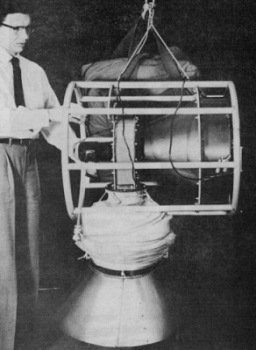Purpose of the flight and payload description
The Upper Atmosphere Monitoring Program (nicknamed Project Ashcan because of the classical shape of the first sampling unit used) was initiated in 1956 as an answer for the pressing need for information concerning the nature, concentration and distribution of radioactive debris injected into the stratosphere during nuclear weapons tests. The main instrument of the project was an impactor collector that was carried out by a stratospheric balloon to obtain samples at preset altitudes between 50.000 and 90.000 feet.
General Mills engineers designed the first "Ashcan" filter sampler which utilized a Torrington 403 blower. A critical re-examination of the system led to several improvements over the following months, but still it most serious deficiency was the low filtering efficiency of the unit. To overcome this, in 1958 was introduced the Direct Flow Filter Sampler shown at left. This unit utilized one square foot of IPC filter paper instead of the five square feet used by the Ashcan sampler. Flow rates of 500 to 800 cubic feet per minute were achieved through use of a Torrington 704 blower, powered by a 0.52 hp Westinghouse aircraft motor. This unit presented a number of advantages with respect to weight, ease of handling, etc, but most important was the higher efficiency achieved. The Direct Flow Sampler replaced the Ashcan filter sampler at San Angelo, Texas since early 1960. Units initially flown from that base were powered by surplus Torrington 403 blowers at some sacrifice in performance, but all units flown after April 1, that year used the larger Torrington 704 blower. Years later the program suffered new improvements and modifications in the equipment used.
ASHCAN program was run in a monthly basis, with regular flights from Alaska, Australia, Brazil, Panama, and in several sites of the United States. Also special missions were performed to analize certain events like the debris left by the reentry of soviet satellites carrying small nuclear reactors, or after volcanic eruptions. The program was terminated in 1983.
Details of the balloon flight
Balloon launched on: 9/11/1962
Launch site: Goodfellow Air Force Base, San Angelo, Texas, US
Balloon manufacturer/size/composition: Zero Pressure Balloon
Flight identification number: T-701
End of flight (L for landing time, W for last contact, otherwise termination time): ??/??/1962
Aditionally to the Direct Flow Sampler, this flight also carried a second type of sampler, the Sub Micron Aerosol Collector (SMAC) developed by General Mills under contract to the Air Force Cambridge Research Laboratory, that was being tested in comparison flights with the Direct Flow Sampler. The SMAC is a modified ASHCAN unit using the same blower and motor system but the filter media used is made from polystyrene fibers. The pressure drop across this paper is approximately ten times that of IPC. A drum capable of supporting ten square feet of the organic fibers, therefore, has been substituted.
External references
- High Altitude Balloon Sampling Program in HASL-135 Fallout Program Quarterly Summary: Dec. 1962 - March 1963
- High Altitude Balloon Sampling Program in HASL-140 Fallout Program Quarterly Summary Report, June - Sept. 1963
8255If you consider this website interesting or useful, you can help me to keep it up and running with a small donation to cover the operational costs. Just the equivalent of the price of a cup of coffee helps a lot.


